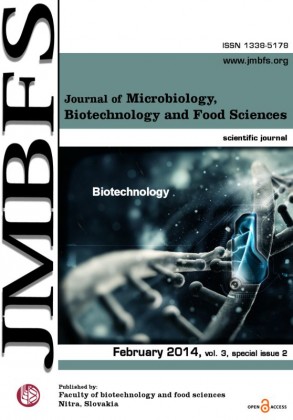FEASIBILITY OF HYGROMYCIN AS A SELECTION AGENT IN AGROBACTERIUM-MEDIATED TRANSFORMATION OF OILSEED RAPE (BRASSICA NAPUS L.)
Keywords:
Agrobacterium tumefaciens, Brassica napus L., β-glucuronidase gene, hygromycin, oilseed rape, tobaccoAbstract
In this work the feasibility of the antibiotic hygromycin as a selection agent in Agrobacterium-mediated transformation of oilseed rape (Brassica napus L.) was evaluated. For this, two economically important commercial varieties Haydn and Hunter and tobacco as a model plant were subjected to Agrobacterium-mediated transformation. The 5-6 days-old oilseed rape hypocotyls and 4-6 weeks-old tobacco leaf segments were transformed with the binary vector pCambia1304. The T-DNA contained the reporter gfp:gus and the selectable marker htp genes. Regeneration of transformed cells was conducted under selection of 10 mg.l-1 (oilseed rape) and 30 mg.l-1 (tobacco) hygromycin. Putative transgenic plantlets were analysed by the mean of the histochemical GUS and PCR analyses. Transformation efficiency ranged from 1.0% (cv. Haydn) to 40.4% (tobacco). No transgenic shoots were detected for the cv. Hunter. It points out the oilseed rape cultivar specificity plays significant role in choice of suitable selection agent.Downloads
Download data is not yet available.
Downloads
Published
2014-02-01
How to Cite
KuÅ¥ka Hlozáková, T., Polóniová, Z., & MoravÄÃková, J. (2014). FEASIBILITY OF HYGROMYCIN AS A SELECTION AGENT IN AGROBACTERIUM-MEDIATED TRANSFORMATION OF OILSEED RAPE (BRASSICA NAPUS L.). Journal of Microbiology, Biotechnology and Food Sciences, 3(special issue 2 (Biotechnology), 80–83. Retrieved from https://office2.jmbfs.org/index.php/JMBFS/article/view/7628
Issue
Section
Biotechnology
License
Copyright (c) 2014 TÃÂmea KuÅ¥ka Hlozáková, Zuzana Polóniová, Jana MoravÄÃková

This work is licensed under a Creative Commons Attribution 4.0 International License.
All papers published in the Journal of Microbiology, Biotechnology and Food Sciences are published under a CC-BY licence (CC-BY 4.0). Published materials can be shared (copy and redistribute the material in any medium or format) and adapted (remix, transform, and build upon the material for any purpose, even commercially) with specifying the author(s).

